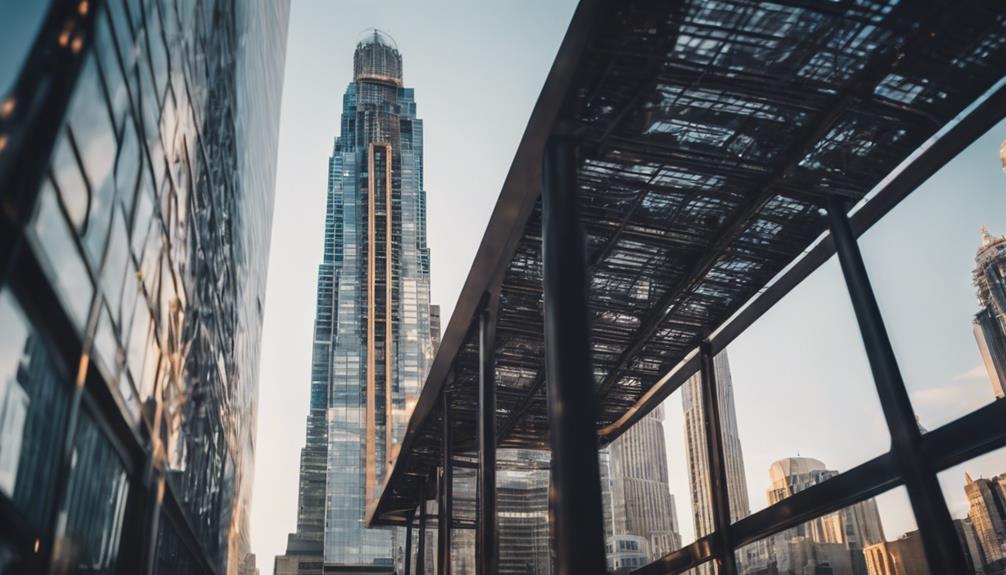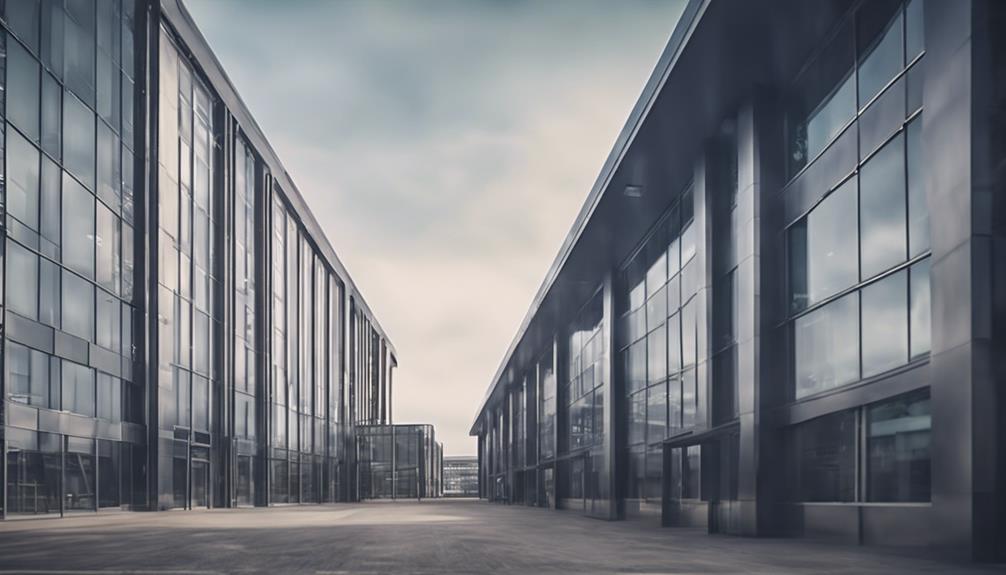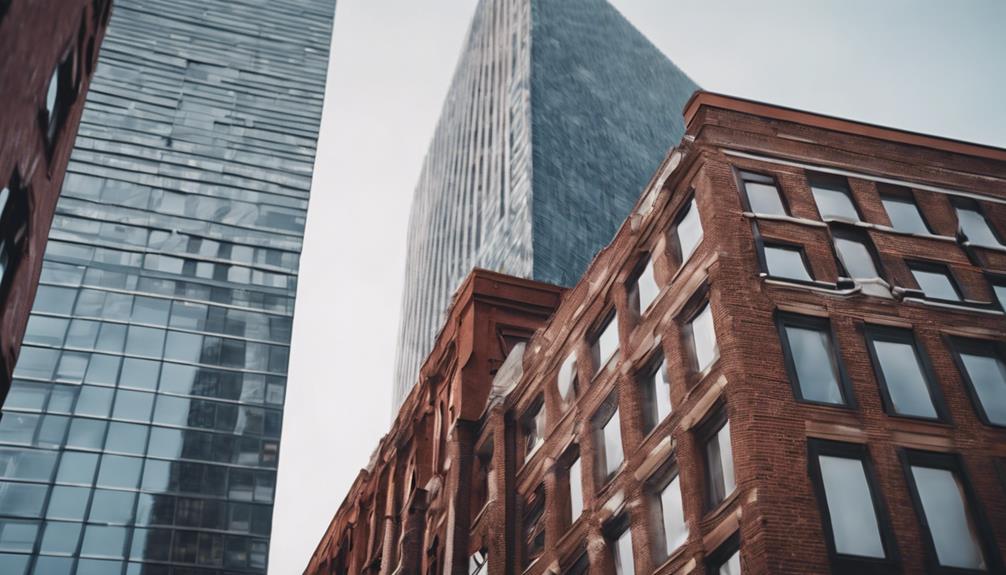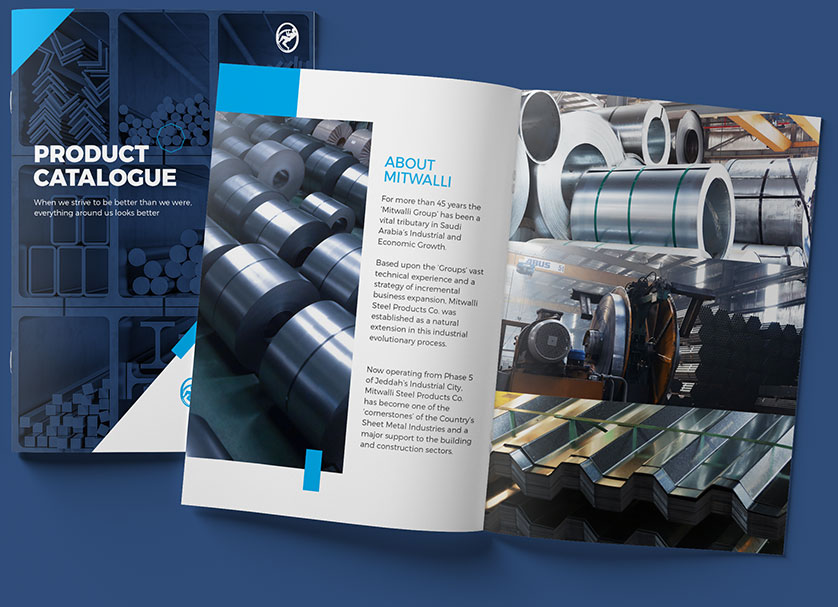
How Steel Construction Reshape Commercial Landscape?
Steel constructions have fundamentally reshaped commercial landscapes, influencing skylines, efficiency, and aesthetics. They offer durability, efficiency, and safety benefits, reducing maintenance costs and optimizing space utilization. Steel structures contribute to modernizing city skylines, enabling the construction of iconic skyscrapers and unique landmarks. The cost-effectiveness of steel buildings, with lower project costs and quicker construction times, guarantees high returns on investment. Their aesthetic transformation enhances commercial landscapes, creating visually striking buildings that make a bold statement. Learn more about the impact of steel structures on urban architecture and the efficiency and cost-effectiveness they bring to commercial projects.
Key Takeaways
- Steel constructions revolutionize commercial landscapes with durability, efficiency, and safety benefits.
- Customizable floor plans optimize space usage in commercial settings, enhancing functionality.
- Steel structures contribute to modern skylines by enabling iconic skyscrapers and unique designs.
- Rapid construction with steel reduces project timelines, ensuring faster occupancy of commercial spaces.
- Aesthetic transformation through steel constructions adds sophistication and makes bold statements in urban settings.
Benefits of Steel Constructions in Commercial Landscapes

Steel constructions in commercial landscapes offer unparalleled benefits that redefine the standards of durability, efficiency, and safety in modern architectural design.
The use of steel in construction brings superior durability and longevity, reducing maintenance costs over time. This durability guarantees that commercial buildings can withstand the test of time, maintaining their structural integrity and aesthetic appeal.
Additionally, steel’s flexibility allows for open and customizable floor plans, optimizing space utilization in commercial settings. This flexibility not only enhances the functionality of the space but also provides architects and designers with creative freedom in their designs.
Furthermore, steel structures boast excellent fire resistance properties, greatly enhancing the safety and security of commercial properties and their occupants.
The incorporation of steel in commercial construction projects also enables faster project completion, leading to quicker occupancy and revenue generation for developers.
Impact of Steel Structures on Urban Skylines
Enhancing urban skylines with their remarkable presence, steel structures revolutionize the architectural landscape by enabling the creation of iconic and innovative designs that define modern cityscapes. The use of stainless steel constructions in urban settings contributes greatly to the modernization and evolution of city skylines. Steel’s strength and flexibility allow for the construction of tall, iconic skyscrapers that serve as focal points in urban environments, attracting attention and admiration.
Architects leverage the capabilities of stainless steel to design unique and landmark buildings that stand out amidst the crowded city skyline. The incorporation of steel in urban construction projects not only offers a wide range of design possibilities but also elevates the overall aesthetic appeal and visual impact of cityscapes worldwide. These steel structures not only add a touch of modernity and sophistication to urban settings but also symbolize progress and innovation in architectural practices. The use of stainless steel in urban construction is undeniably reshaping and enhancing urban skylines across the globe.
Cost-Effectiveness of Steel Buildings

With their efficient cost structures and sustainable advantages, steel buildings have emerged as a compelling choice in modern construction practices. The cost-effectiveness of steel buildings stems from various factors that make them an appealing option for developers and investors.
Steel constructions offer lower overall project costs and increased Internal Rate of Return (IRR) compared to traditional construction methods. By reducing steel consumption by 7-10%, construction projects benefit from significant cost savings. Additionally, steel buildings contribute to environmental sustainability by emitting 30% less CO2 and consuming less groundwater.
The quick construction speed of steel structures further enhances their cost-effectiveness by saving time and labor expenses. Moreover, the durability, longevity, and low maintenance requirements of steel buildings ensure a high return on investment (ROI) for stakeholders.
To achieve these benefits, working closely with reputable construction steel suppliers is vital to guarantee quality materials and efficient project delivery.
Efficiency in Construction with Steel
Efficiency in construction practices is paramount when considering the advantages of steel structures, as their streamlined assembly processes and prefabricated components greatly contribute to cost savings and accelerated project timelines. Steel constructions offer quicker construction times compared to traditional methods, making them a popular choice for many projects.
Steel construction companies leverage prefabricated steel components to minimize on-site labor and material waste, further enhancing effectiveness. By reducing overall project expenses and speeding up construction schedules, steel buildings provide a cost-effective solution for businesses looking to optimize their investments.
The high durability of steel structures guarantees long-term structural integrity, requiring minimal maintenance over time. Additionally, the rapid assembly of steel buildings allows for faster occupancy of commercial spaces, enabling businesses to start generating revenue sooner.
The efficiency of steel construction not only benefits the construction process but also positively impacts the overall success of commercial projects.
Aesthetic Transformation by Steel Constructions

Steel constructions in commercial landscapes undergo a remarkable aesthetic transformation, as architects and designers leverage the material’s versatility to create visually mesmerizing buildings that redefine urban environments. The use of structural steel construction in commercial landscapes focuses on enhancing aesthetics through unique shapes and designs, offering flexibility for architects to craft visually striking buildings that stand out in urban settings.
By incorporating steel into construction, designers can explore innovative and creative architectural expressions that push the boundaries of traditional building aesthetics. The modern and sleek look provided by steel constructions adds a touch of sophistication to commercial spaces, attracting attention and making a bold statement.
In addition, steel’s versatility in design enables the creation of iconic landmarks that reshape the visual landscape of commercial areas, contributing to a sense of uniqueness and modernity in urban architecture. Overall, structural steel construction plays a pivotal role in the aesthetic evolution of commercial landscapes, setting new standards for architectural creativity and visual appeal.
To sum up, steel constructions play a significant role in reshaping commercial landscapes by offering numerous benefits such as cost-effectiveness, efficiency in construction, and aesthetic transformation.
The impact of steel structures on urban skylines is undeniable, contributing to the modernization and sustainability of commercial developments.
With these advantages, steel buildings have become a popular choice for commercial projects, leading to a shift in the architectural landscape towards more durable and versatile structures.
Frequently Asked Questions
Why is Steel used in Commercial Buildings?
Steel is used in commercial buildings due to its high strength-to-weight ratio, design flexibility, durability against environmental factors, prefabrication capabilities, and recyclability. These qualities make steel a reliable, efficient, and sustainable choice for modern commercial construction projects.
What is the Commercial form of Steel in Construction?
In commercial construction, steel takes the form of structural beams and columns, providing essential support for floors, roofs, and facades. Its ability to be shaped into various profiles and sizes offers flexibility in meeting specific design requirements.
What is the Impact of Steel in Architecture?
Steel in architecture greatly impacts the industry by offering structural integrity, durability, and aesthetic appeal. Its versatility, strength-to-weight ratio, and sustainable properties make it a preferred material for creating innovative designs that stand the test of time.
What Makes Steel an Extremely Attractive Construction Material?
Steel’s allure as a construction material stems from its sustainability, seismic resilience, and eco-friendly reputation. China’s ambitious steel consumption targets and national initiatives like One Belt, One Road further boost its appeal, driving a shift towards prefabricated steel structures.

Add New Comment